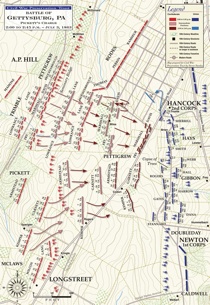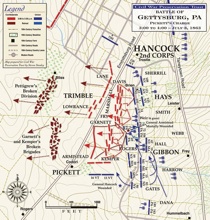The assault known as Pickett’s Charge is often called the High Water Mark of the Battle of Gettysburg and even the High Water Mark of the Confederacy. When the charge failed to dislodge Union Army troops atop Cemetery Ridge, Robert E. Lee had little choice but to withdraw his Army of Northern Virginia from Pennsylvania. "The Great Invasion" was over.
"Pickett’s Charge" actually consisted of three Confederate divisions: Major General George Pickett’s division formed the right of the assault line; that of Brigadier General James Johnston Pettigrew, supported to the rear by two brigades of Maj. Gen. Isaac Trimble’s division, comprised the left. Pickett’s division had not yet seen action at Gettysburg and was the largest of the three that day.
The maps below, showing the Confederate advance, its "high water mark" and repulse, are property of the Civil War Trust, a nonprofit organization dedicated to preserving the hallowed ground of battlefields of the American Civil War, and are used here with permission. Clicking on them will link to larger versions on the Website of the Civil War Trust,
Battle of Gettysburg, Pickett’s Charge 2:00–3:00 p.m.
Battle of Gettysburg, Pickett’s Charge 3:00–4:00 p.m.


